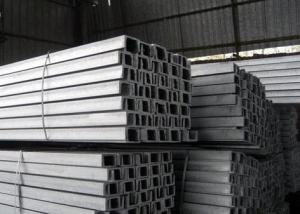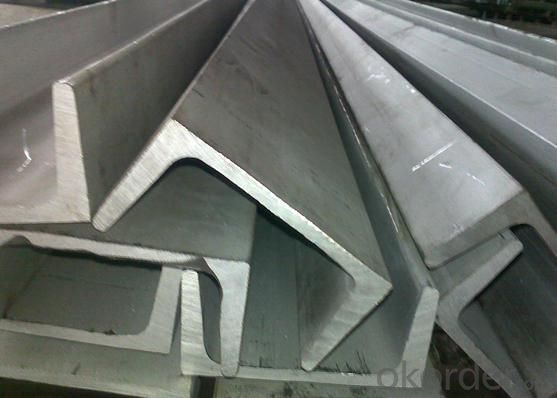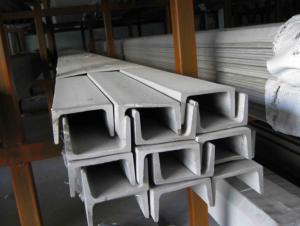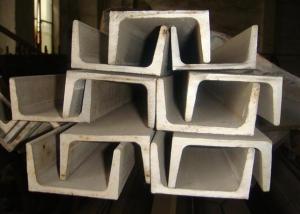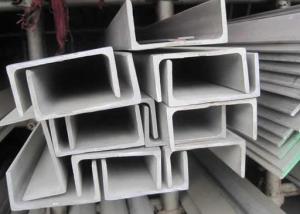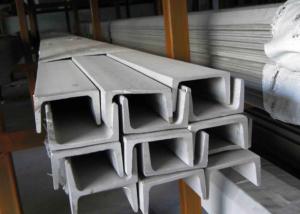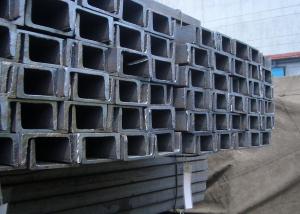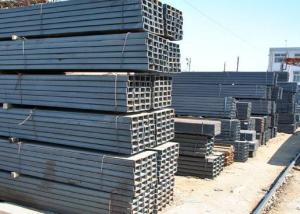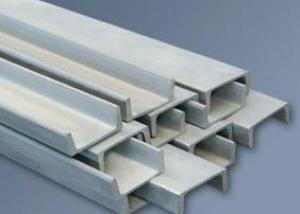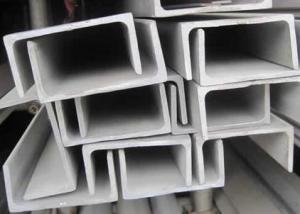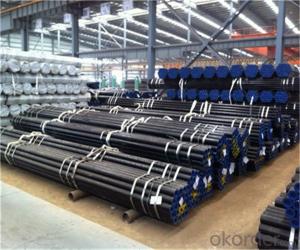Best Quality for 304 Stainless Steel Channels
- Loading Port:
- China Main Port
- Payment Terms:
- TT or LC
- Min Order Qty:
- 5 Tons m.t.
- Supply Capability:
- 1000 Tons Per Month m.t./month
OKorder Service Pledge
OKorder Financial Service
You Might Also Like
Stainless Steel Channels
General Informaiton of Stainless Steel Channels
Stainless Steel Channel, is ideal for all applications where greater strength and superior corrosion resistance is required.
Stainless Channel has a durable dull, mill finish that is widely used for all types of fabrication projects that are exposed to the elements - chemical, acidic, fresh water, and salt water environments.
The standard length for most size channel is 12’-14’ random lengths, but lengths are available in some sizes up to 20’ and longer.
Finishes on channel can vary and include cold drawn, center less ground; smooth turned, rough turned, turned ground and polished, and HRAP.
1. We will custom saw cut to length
2. DEFARS or domestic material available in many sizes
3. Polishing services are available
Spefification of Stainless Steel Channels
Product Name | Stainless Steel Channel |
Standard | JIS, ASTM, GB, DIN, EN, AISI |
Grade | 301,302,303,304,304L,305,309S,310S,316,316L,317,317L,321,347 631... |
Diameter | 75x30x6mm many other sizes can be done |
Length | 1m~6m |
Package Detail | Export standard package, bundled or be required. The inner size of container is below: 20ft GP: 5.9m(length) x 2.13m(width) x 2.18m(high) about 24-26CBM 40ft GP: 11.8m(length) x 2.13m(width) x 2.18m(high) about 54CBM 40ft HG: 11.8m(length) x 2.13m(width) x 2.72m(high) about 68CBM |
Delivery Time | Normally according to the order quantity or upon negotiation |
Payment Terms | L/C, T/T |
Application | Food stuff, gas, metallurgy, biology, electron, chemical, petroleum, boilers, nuclear, energy, construction field, ships building industry, war and electricity industry, boiler heat exchanger, machinery and hardware fields and medical equipment, fertilizer, etc. |
Contact | Our products are very popular because of high-quality and reasonable prices. If you are interested in any of our products, please feel free to contact us for more information. |
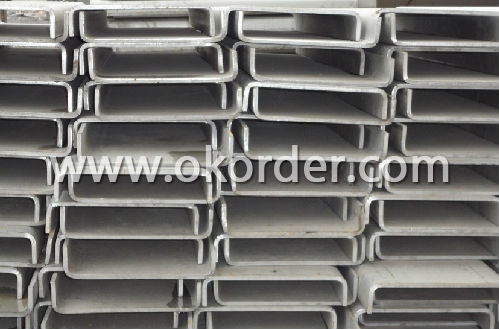
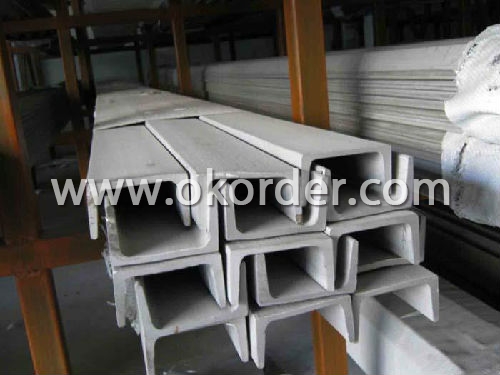
- Q: How do stainless steel channels perform in acidic environments?
- Stainless steel channels are renowned for their exceptional resistance to corrosion, making them highly suitable for usage in acidic surroundings. The inclusion of chromium in stainless steel forms a protective oxide layer on the surface, which acts as a barrier against corrosion. This oxide layer remains stable and has the ability to self-heal, enabling stainless steel channels to endure exposure to various acids, including sulfuric acid, hydrochloric acid, and nitric acid. In acidic settings, stainless steel channels exhibit outstanding resistance to both uniform corrosion and localized corrosion, such as pitting and crevice corrosion. This resistance holds significant importance in industries where handling acidic solutions or gases, such as chemical processing, pharmaceuticals, food and beverage, and wastewater treatment plants. Furthermore, stainless steel channels possess excellent strength and durability, ensuring their long-term performance in acidic environments. They can endure both high and low temperatures encountered in such surroundings without experiencing considerable degradation or loss of mechanical properties. Nevertheless, it is important to acknowledge that the performance of stainless steel channels in acidic environments may vary depending on the specific grade of stainless steel implemented. Grades with higher alloy content, such as 316 and 317, exhibit greater resistance to corrosion in acidic environments compared to lower alloy grades like 304. Consequently, selecting the appropriate grade of stainless steel channel based on the specific acid concentration, temperature, and other operational conditions in the application is of utmost importance.
- Q: What are the different bending or forming options for stainless steel channels?
- There are several bending or forming options available for stainless steel channels, depending on the desired shape and application. Some of the common methods include: 1. Roll Forming: This process involves passing the stainless steel channel through a series of rollers to gradually bend it into the desired shape. Roll forming is suitable for long lengths of channels and can achieve consistent and precise bends. 2. Press Brake Bending: Press brake machines use a punch and die set to bend the stainless steel channel. This method is versatile and can produce a variety of different bend angles and shapes. It is commonly used for shorter lengths or smaller quantities. 3. Mandrel Bending: In this technique, a mandrel is inserted into the stainless steel channel to support the inner wall during bending. This ensures the channel retains its shape and avoids any deformation or wrinkling. Mandrel bending is ideal for achieving tight bends with a small radius. 4. Rotary Draw Bending: This method involves clamping the stainless steel channel into a die and using a rotating draw bend die to create the bend. The channel is pulled around the die, resulting in accurate and consistent bends. Rotary draw bending is commonly used for complex shapes and tight radius bends. 5. Heat Bending: Stainless steel channels can also be bent by applying heat to the specific area that requires bending. This method allows for greater flexibility and can achieve more intricate shapes. However, it requires skilled operators and precise temperature control to avoid overheating or damaging the material. It is important to consider the specific requirements of the stainless steel channel and consult with a professional fabricator or manufacturer to determine the most suitable bending or forming option.
- Q: Can stainless steel channels be used in the construction of pipe supports?
- Yes, stainless steel channels can be used in the construction of pipe supports. Stainless steel channels are commonly used in various industries, including construction, due to their durability, corrosion resistance, and strength. They provide a reliable and sturdy framework for supporting pipes, ensuring their stability and preventing any potential sagging or movement. Stainless steel channels are available in different sizes and configurations, making them versatile and suitable for various pipe support applications. Additionally, stainless steel's resistance to corrosion makes it an ideal choice for pipe supports, as it can withstand exposure to moisture and harsh environmental conditions, ensuring long-term durability and reliability.
- Q: What are the different options for weatherproofing stainless steel channels?
- There are several options for weatherproofing stainless steel channels, depending on the specific requirements and environmental conditions. Here are some common methods: 1. Powder Coating: This is a popular option as it provides a durable and protective finish to stainless steel channels. Powder coating involves applying a dry powder to the surface and then heating it to form a hard, protective layer that is resistant to weathering and corrosion. 2. Electroplating: Electroplating is a process where a thin layer of another metal, such as zinc or chrome, is applied to the stainless steel channel through an electrochemical reaction. This layer acts as a barrier against moisture and other weather elements, providing enhanced weatherproofing. 3. Epoxy Coating: Epoxy coatings are often used to weatherproof stainless steel channels in harsh environmental conditions. These coatings offer excellent resistance to moisture, chemicals, and UV radiation. Epoxy coatings can be applied as a liquid or powder and are cured to form a hard, protective layer. 4. Polymer Coating: Polymer coatings, such as polyurethane or polyvinyl chloride (PVC), are commonly used for weatherproofing stainless steel channels. These coatings provide a strong barrier against moisture, UV rays, and other weather elements, ensuring long-term protection. 5. Hot-dip Galvanizing: This method involves immersing the stainless steel channel in a bath of molten zinc, which forms a thick, corrosion-resistant coating on the surface. Hot-dip galvanizing is particularly effective for outdoor applications, providing excellent weatherproofing and corrosion resistance. 6. Stainless Steel Passivation: Passivation is a chemical process that removes iron contaminants from the surface of stainless steel channels, enhancing their resistance to corrosion and weathering. This method is often used in conjunction with other weatherproofing techniques to ensure optimal protection. It is important to consider the specific application and environment when choosing the appropriate weatherproofing option for stainless steel channels. Consulting with a professional or manufacturer can help determine the most suitable method for the desired level of weatherproofing.
- Q: How do stainless steel channels perform in earthquake-prone areas?
- Stainless steel channels have shown to perform exceptionally well in earthquake-prone areas due to their unique properties and structural characteristics. The high strength, durability, and corrosion resistance of stainless steel make it an ideal material for withstanding seismic activity. During an earthquake, stainless steel channels exhibit excellent ductility, which allows them to absorb and distribute the energy generated by the seismic forces. This ability to deform without fracturing or failing significantly enhances their performance in earthquake-prone areas. Stainless steel's high tensile strength also enables it to resist bending and buckling, further enhancing its seismic performance. Additionally, stainless steel channels have a high resistance to corrosion, which is crucial in areas prone to earthquakes. The corrosive environment caused by seismic activity, such as exposure to moisture and chemicals, can deteriorate the structural integrity of traditional steel channels. However, stainless steel's resistance to corrosion ensures that it maintains its strength and structural integrity over time, reducing the risk of failure even after repeated earthquakes. Furthermore, stainless steel channels are lightweight compared to other construction materials, allowing for easier transportation and installation. This lightweight property reduces the overall load on the structure, which is beneficial during an earthquake as it decreases the forces acting on the building. In conclusion, stainless steel channels perform exceptionally well in earthquake-prone areas due to their high strength, ductility, corrosion resistance, and lightweight nature. These properties make them a reliable and durable choice for constructing earthquake-resistant structures, ensuring the safety and longevity of buildings in such areas.
- Q: Are stainless steel channels suitable for industrial walkways?
- Yes, stainless steel channels are suitable for industrial walkways. Stainless steel is known for its durability, strength, and resistance to corrosion, making it an ideal material for industrial applications. Stainless steel channels provide stability and support, ensuring safe and sturdy walkways in industrial settings.
- Q: What are the different surface colors available for stainless steel channels?
- The different surface colors available for stainless steel channels include silver, brushed silver, matte black, and bronze.
- Q: What are the different methods of joining stainless steel channels together?
- There exist various techniques for connecting stainless steel channels, which rely on the specific purpose and desired joint strength. 1. Welding: Joining stainless steel channels through welding is a widely employed approach. This method involves heating and melting the channel edges, subsequently fusing them together. To enhance the bond, heat and, occasionally, a filler metal are utilized. Different welding techniques, like TIG or MIG welding, can be selected based on the joint's particular requirements. 2. Bolting: Another method for connecting stainless steel channels is bolting. This approach necessitates the use of bolts, washers, and nuts to secure the channels firmly in place. Bolting allows for easy dismantling and reassembly if necessary, making it suitable for applications requiring frequent adjustments or modifications. 3. Adhesive bonding: Adhesive bonding involves the application of high-strength adhesives to connect stainless steel channels. The adhesive is spread onto the channel surfaces and subsequently pressed together, generating a sturdy bond once the adhesive cures. This technique is typically employed when welding or bolting may not be feasible, particularly for thin or delicate stainless steel channels. 4. Mechanical fastening: Mechanical fastening techniques, such as riveting or clinching, can also be employed to connect stainless steel channels. These methods employ mechanical force to deform the channels or insert fasteners, creating a secure connection. Riveting entails driving a rivet through the channels using a rivet gun, while clinching involves deforming the channels to create interlocking tabs or joints. 5. Flange connections: Flange connections are commonly utilized in industrial applications to connect stainless steel channels. Flanges are affixed to the ends of the channels, and bolts or other fasteners are used to secure the flanges together. This technique ensures a robust and leak-proof joint, making it suitable for airtight or watertight connections. Each method possesses its own merits and drawbacks, and the selection of the joining technique depends on factors such as the intended application of the channels, the required joint strength, and the availability of equipment and resources.
- Q: Are stainless steel channels suitable for high-traffic areas?
- Yes, stainless steel channels are suitable for high-traffic areas. Stainless steel is highly durable, corrosion-resistant, and can withstand heavy use and foot traffic. It is also easy to clean and maintain, making it an ideal choice for areas with high footfall such as airports, shopping malls, and train stations.
- Q: How do stainless steel channels compare to galvanized steel channels in terms of durability?
- Stainless steel channels are generally more durable compared to galvanized steel channels. Stainless steel is highly resistant to corrosion, rust, and staining, making it suitable for various environments, including harsh ones. On the other hand, galvanized steel channels are coated with a layer of zinc to protect against corrosion, but this coating can wear off over time, leaving the steel vulnerable to rust. Therefore, if long-term durability is a priority, stainless steel channels are a better choice.
Send your message to us
Best Quality for 304 Stainless Steel Channels
- Loading Port:
- China Main Port
- Payment Terms:
- TT or LC
- Min Order Qty:
- 5 Tons m.t.
- Supply Capability:
- 1000 Tons Per Month m.t./month
OKorder Service Pledge
OKorder Financial Service
Similar products
Hot Searches
Related keywords


